Clear up your skin with this easy, DIY charcoal face mask which is great for oily, combination, and acne prone skin.
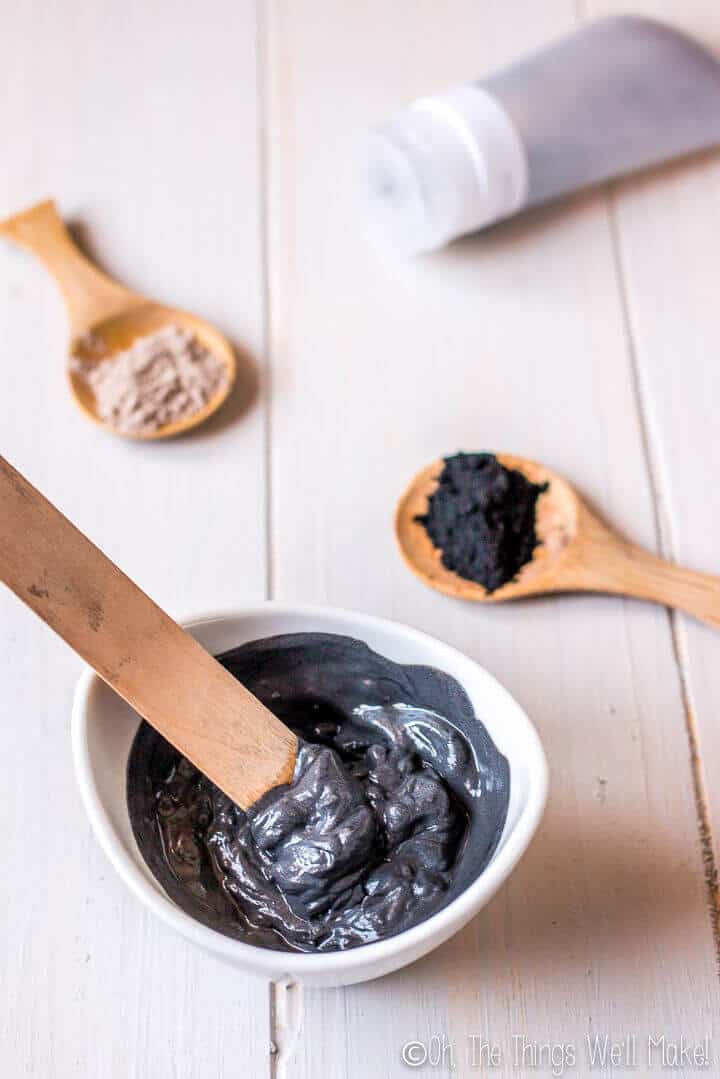
For the last 30 years of my life, I’ve battled with acne.
It all started in my teens, and when it was at its worst, I was using topical medications like Retin A, and taking antibiotics every day. I didn’t realize that there were any cons to taking antibiotics all of the time, and just did what my dermatologist suggested. I had no idea that beneficial bacteria grew within our digestive tract, and didn’t know that my constant antibiotic use was killing them all off.
To be honest, I’m not even sure that my skin was really that much better while using everything prescribed by my dermatologist, but I continued to use everything in the hopes of one day having perfect skin.
Watch me make the DIY Charcoal Face Mask
Ways to prevent acne
Fast forward many years, I still don’t have perfect skin, but I am much more able to control my acne.
My skin is noticeably better when I’m eating lots of vegetables, clean meats, fish, and eggs, and limited sugars and processed foods. I’m pretty sure that dairy and sugars aggravate both my skin and my digestive issues, so I try to mostly avoid them, or stick to having small amounts occasionally rather than eat those sorts of foods every day. My triggers might not be the same as yours, but my suspicion is that most people with acne will have certain foods that will aggravate it.
I’ve finally started to use a homemade facial cream for oily and acne prone skin that allows me to moisturize without breaking out. I’ve come to realize that not all oils and moisturizers will aggravate acne, and that some non comedogenic oils can actually help balance the oils in your skin to help clear it.
When I do have the occasional breakout, I have found that this DIY charcoal face mask does a really great job of helping to clear up my skin. I also try to remember to use it weekly, even when I’m not battling acne, to help keep my skin clean and clear.
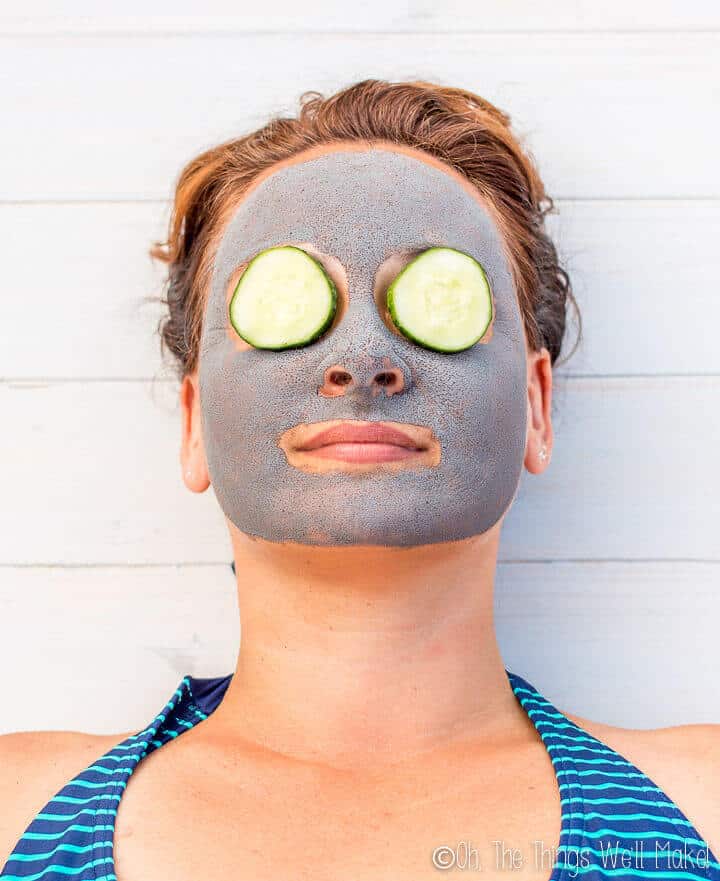
What skin types benefit most from this DIY charcoal face mask?
While everybody can benefit from the occasional facial mask, I think that bentonite clay masks are best for people with oily and combination skin. If your skin is both oily and acne prone, this mask is especially good for you!
People with normal skin may be able to tolerate certain clay masks, especially those made with milder clays, but I think that people with dry and sensitive skin should generally stay away from clay masks and use more hydrating facial masks instead.
What is bentonite clay?
Bentonite clay is a type of clay that is normally formed from broken down volcanic ash, and is a very absorbent clay. It is thought to be antimicrobial, which helps in the fight against acne. It’s also thought to be extremely good at absorbing heavy metals and toxins from surrounding areas. That’s the main reason that most people will say not to store or mix bentonite clay in metal containers.
Bentonite clay is often taken orally by people trying to detox themselves of heavy metals and other toxins, but it is also great as a topical treatment of skin conditions like acne or even eczema and psoriasis.
The pH of bentonite clay
Bentonite clay, like other clays, is naturally alkaline. It’s pH normally falls somewhere between 8 and 9, or just slightly higher than 9, which makes is more alkaline than some other clays that are used for facial masks.
For that reason, some people with sensitive skin find that mixing bentonite clay with water, or anything with a neutral or alkaline pH, can be irritating to their skin.
Distilled witch hazel has a slightly acidic pH, somewhere around 5, so it helps to neutralize the alkalinity of the clay. If you don’t have witch hazel on hand, and don’t want to buy it, you can use plain distilled water instead.
If you have sensitive skin, and find that this DIY charcoal clay mask irritates your skin if mixed with water, you can try using apple cider vinegar or aloe juice as the liquid. Both aloe juice and apple cider vinegar have an acidic pH that will also help neutralize the alkalinity of the bentonite. (Aloe vera juice is said to have a pH of 4.5-5.5, while apple cider vinegar has a pH of between 2.9 and 3.3.)
Why use witch hazel?
Witch hazel is one of my favorite alternatives to distilled water in natural cosmetic recipes. It helps fight against acne, and can also help with skin inflammation, healing sores, killing bacteria within your pores, etc. In this recipe, it also helps to neutralize the alkalinity of the clay which helps make the mask more mild for those with sensitive skin.
I use a distilled witch hazel, rather than one with alcohol in it, and I find it works really well in this facial mask. If you find that witch hazel is irritating to your skin, for whatever reason, though, you can replace it with distilled water, aloe juice, or apple cider vinegar. (Aloe juice or apple cider vinegar are both acidic and will also help balance the pH of the mask.)
The benefits of activated charcoal
I already introduced activated charcoal, and some of its benefits, to you when I shared my recipe for an activated charcoal face soap here on the blog. Lately it is very popular in cosmetics, especially in facial cleansers and masks.
As with bentonite clay, activated charcoal is said to attract toxins to help “detox” your skin. When used in a facial mask, it can help clear out pores which helps make them smaller. It is also thought to help absorb excess oils and balance the oils of your skin, which in turn helps clear up acne.
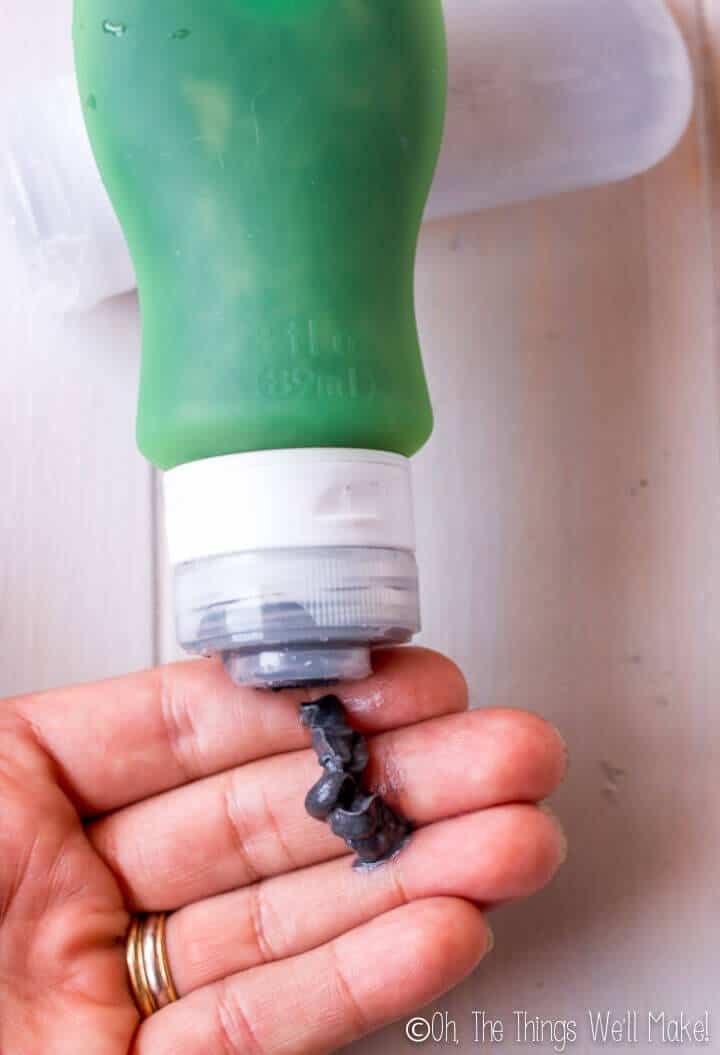
Storing your DIY charcoal face mask (updated)
While it’s simple enough to mix together some activated charcoal, bentonite clay and water or witch hazel whenever you want to make a face mask, it’s much more convenient to mix up some of the ingredients ahead of time so that you can quickly mix up a facial mask when you need it. I’d recommend mixing up the amounts of clay and charcoal below and storing them in a small container, ready for use at your convenience.
When I first wrote this post, I said that you could mix up all of the ingredients, including the liquid ones, add a natural preservative, and store the mask in a silicone travel tube. The silicone tube makes for easy dispensing of homemade products and keeps the probability of microbial contamination to a minimum. I had read several articles online where they suggested saving leftover masks for later and had seen premade masks being sold in the US that were made with similar ingredients. (I didn’t realize until later that products made and sold in the US don’t need microbial testing as they do here in Europe.)
I stored my mask for several months and continued to use it without any issues.
Why do I no longer recommend storing the mixed mask for later?
As with any cosmetic with water in it, bacteria can start to grow in an already hydrated facial mask. My belief was that because the pH of bentonite clay tends to be on the high side, it would probably take some time for microbes to grow in it, especially if you begin with a pure clay, use distilled water (or distilled witch hazel), and mix it and conserve it in a way that bacteria aren’t introduced into the product.
I had chosen to use Leucidal to preserve my homemade clay mask (and recommended using 3g in the recipe below). Leucidal is a preservative made from fermenting radishes with a particular strain of bacteria, and I talk more about it in my post about how to make a basic lotion. In the case of this clay mask, I chose it over some of the other natural preservatives that I often use because it is effective at pH levels of up to around 9.
All seemed well and I was happily using my stored mask and loved it.
But then I started taking courses in cosmetic formulation. These are the same courses taken by those who want to start their own natural cosmetic business. One theme that came up quite often is that adding clay to a product makes it much more difficult to preserve. They recommended selling mixed clays as a powder that people can mix with liquid at home.
Clay is supposed to be prone to mold growth. I will say that I never saw mold grow in my stored facial mask. Perhaps that is due to the higher pH of bentonite clay compared with other clays. Liquid soaps normally don’t need preservatives because their pH tends to be above 9. At those higher pH levels microbial growth isn’t likely.
You can normally see mold and that helps you know not to use a product. You can’t really know if your batch has become contaminated by bacteria, though, unless you have it tested, something that isn’t practical or possible for most DIY-ers. That’s why I’d prefer to err on the side of caution and no longer recommend mixing up the facial mask and storing it for later. I think it’s a better idea to mix up the dry ingredients, store them in a small container, and mix up small amounts with your liquid of choice, as needed.
Perhaps bentonite clay isn’t as prone to microbial growth because of its higher pH. I don’t know, but there are too many variables in the recipe for me to feel confident recommending you try to preserve your mask for later anymore. (The pH will vary depending upon the clay used, the liquid used, etc.)
DIY Charcoal Face Mask
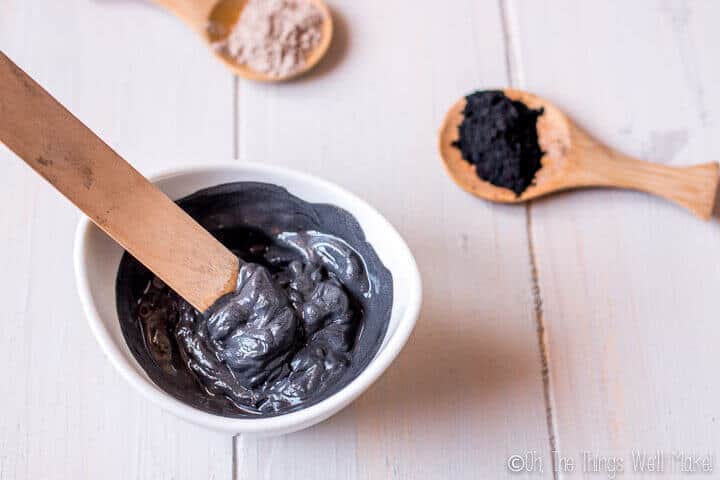
DIY Charcoal Face Mask
Materials
- 3 Tbsp. bentonite clay
- 1 tsp. activated charcoal
- 3 Tbsp. witch hazel or distilled water, or a combination with or without something acidic. (See above.)
- 20 drops tea tree essential oil
Instructions
- If you are using a combination of liquids like water and witch hazel, mix them together now. Remember that if you have sensitive skin, you can neutralize the clay somewhat by using witch hazel, apple cider vinegar, or aloe juice to lower the pH as needed. If using only water, the pH of the mask will be higher, which can be irritating to some people’s skin.
- Mix together the bentonite clay and the activated charcoal using plastic or wooden silverware. (Don’t use a metal bowl.)
- Add the clay mixture to the liquid mixture, and allow the clay to absorb the liquid little by little.
- Stir together all of the ingredients, mixing them until they are well combined.
- You can now apply the facial mask by spreading a thin layer of the mask all over the face, leaving the area around your eyes and your lips uncovered.
- Allow the mask to completely dry.
- Rinse the mask off completely with cool water and gently pat your skin dry.
 Español
Español
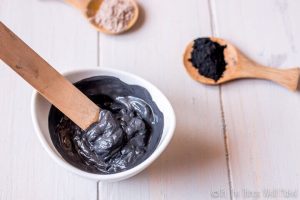

 How to Make a Homemade Dog Shampoo Bar Soap
How to Make a Homemade Dog Shampoo Bar Soap
F h forever
Your blog was absolutely fantastic! Large amount of great information which is often attractive some and the other way.Thanks.
Tiniya
Love your newsletter!! But im thinking of selling this on my shop when i grow. Is it possible i could add a liquid and store it? If so whats the shelf life? Because i feel like my younger customers are not going to understand what to do if i just send them powder even if i put instructions
Tracy Ariza, DDS
Hi Tiniya,
From what I understand, it’s very difficult to preserve products with clays because the clay will absorb the preservative in a way that the whole product isn’t able to be preserved.
I did preserve my homemade mixed clay mask before I knew better, and I didn’t see any mold or any obvious problems, but that doesn’t mean bacteria wasn’t building up, etc.
For selling products, you have to be even more careful as you could be liable for any issues that somebody has with a product that isn’t properly preserved. I don’t know enough about how clay masks can be properly preserved.
Shani
Is there anything apart from Apple cider vinegar or witch hazel to lower the PH? Can’t find pure aloe gel either. It’s all mixed with an essential oil. Unless that’s okay? Lime essential oil to be specific. Also would there be a way to convert this into a peel off mask?
Shani
Also if we can’t find bentonite clay – is there a replacement?
Tracy Ariza
You can definitely experiment with other clays!
Bentonite is known to be great for clearing out pores, but other clays work well too. They may have slightly different properties, but that’s the fun of experimenting. 😉
Tracy Ariza
Hi Shani,
I doubt that lime essential oil would lower the pH. Lime juice would, though.
For peel-off masks, you can play with using gelatin, but be careful as they can pull on the skin!
You’d have to make the gelatin be the bulk of the recipe and reduce the other ingredients.
Amy Brasher
My daughter is allergic to tea tree oil (and cedar oil). Is there a good substitute for it in this recipe?
Tracy Ariza
Hi Amy,
In all honesty, you don’t need to add any essential oils to this. I forgot in one of the batches, and it’s a great soap either way. The tea tree oil only adds a bit of fragrance and may help slightly with acne (although my best guess is that in a soap format it can’t really be concentrated enough to really help with that).
Feel free to use other oils you like (lavender and rosemary are some of my faves) or none at all! 😉
Krissy
How long can we store a mixed mask?
Tracy Ariza
Hi Krissy,
When I first posted this, I have to admit that I was premixing the masks and added a preservative and stored it in a silicone tube. I actually stored it that way and was using it over the course of a month or two.
I later read in a cosmetics formulation class that it is very difficult to preserve clays once mixed with water. They are very prone to microbial growth. So, even they didn’t make any formulations with pre-mixed clay!
In the end, despite the fact that I never had any problems with mine, I decided to recommend mixing right before use.
Bacteria can form that we can’t see- and I wouldn’t want anybody to have problems because I was suggesting to pre-mix. So, to err on the side of caution, I’d recommend mixing together your powders for storing and then adding a small amount of liquid to a small amount of the powder right before using the mask.
Robert Clark
How long can you leave the betonite And charcoal after mixed with water at room temperature
Tracy Ariza
Hi Robert,
That’s a good question that is kind of hard to answer.
I’ve done it for several days and the water eventually evaporates, and then you can add more water as needed to use again.
The problem is that they say that clays are prone to microbial growth and have a tendency to make preservation difficult.
The idea is that you could end up with a lot of bacteria that you can’t see in the product, which is why they normally suggest that you mix up the clay freshly each time you use it. (Thay can also get moldy, supposedly, but I’ve never had that problem.)
Before I knew any of that, I had been reusing mine for several days and never noticed any issues- but perhaps ignorance is bliss?
It’s all what you feel comfortable doing as long as you know the possible risks. 😉
Divya
Hi Tracey,
I made this mask and applied it immediately. I tripled the quantities you mentioned as I wanted more if it. So I added more of tea treeoil too… about 40 drops of it. Is that fine? I can feel a strong stinging in my eyes and face as I apply this mask.. is that normal?
Tracy Ariza
Hello,
Each of us is different, so some people are going to be more sensitive than others. You may have added too much tea tree oil for your skin (or this type of mask may just be too harsh for your skin type). You should also be very careful when using the mask around your eyes no matter what. Try to keep from using it too close to your eyes.
If you are experiencing irritation with this mask, you may want to try using less tea tree oil, or use one of the other liquids to try to lower the pH somewhat. You can also try cleaning it off before it fully dries. Some people can’t handle the mask for as long as it takes for it to completely dry.
If it still bothers you, this may not be the best mask for you. Clay masks, in general, can be a bit harsh for people with sensitive skin. That’s why they are usually recommended for people with oily/acne prone skin. Dry skin tends to be more sensitive and clay masks can be drying and irritating for those skin types. The gray is area is with people with oily, acne prone skin that is also sensitive. You have to be the one who can decide if your skin can handle it. Try to space out applications as needed.
Some tingling is normal, but I’m not sure I’d call it a stinging feeling, but if you have a lot of tea tree oil, that may be causing that sensation. My skin handles tea tree oil pretty well, but not everybody can handle it in high doses.
I wish I could be of more help, but it really depends on you and your own skin.